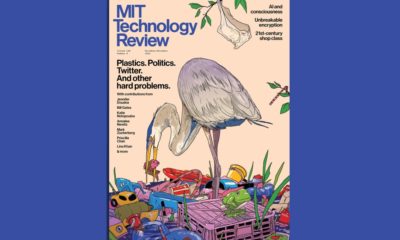Politics
Is AI Our Friend or Our Foe in Tackling the Novel Coronavirus? – ReadWrite
Published
3 years agoon
By
Drew Simpson
From the way we greet friends to the way we bag our groceries, the novel coronavirus has managed to make us reconsider even the most basic tasks in our day-to-day living. We’re more cautious and prudent, and even some of us have been called paranoid in the way we manage these interactions.
To put it mildly, COVID-19 has completely transformed the way we live as human beings, and it’s likely that these effects will continue to linger long after the pandemic has run its course.
Is AI Our Friend or Our Foe in Tackling the Novel Coronavirus?
One of the biggest challenges we’ve faced during this pandemic isn’t just how we’re dealing with the illness itself; it’s also how we’re coping with it as social creatures, too.
Many people continue to refuse to acknowledge the virus’s mere existence, making it all the more difficult to contain it. Because of this, the virus continues to spread at a prolific pace, despite social distancing protocols in place and the introduction of several promising new vaccines.
With AI on the front lines — we can watch the COVID-19 virus and its varients at an unprecedented level that was unknown in the past.
However, there is one lesser-understood ally hidden in the midst of our new normal, and that’s artificial intelligence (AI). AI technology has made it possible for scientists and researchers to try to predict future outbreaks and analyze the current virus itself to detect mutations in the strains.
AI is still ahead as the best predictor of which patients need extra care and watch-care help.
Not only that, but AI is also being utilized to predict which types of patients will have more severe symptoms and fall critically ill, and which ones will merely come down with a particularly annoying case of the sniffles. There is even a widespread effort to find a cure deep within the virus’s genetic code, and AI is at the forefront of this effort.
The success rates of AI in fighting, not only this virus — but many viruses to come.
No doubt, AI can be our biggest weapon in combating coronavirus, but its success is still largely unknown. Nevertheless, researchers doggedly continue to use it, despite knowing it is fraught with potential flaws.
This begs the question: are we becoming too codependent upon AI technology to save us from COVID-19 — and will our impatience to contort it to fit the mold of being our salvation actually backfire, leading to potential long-term risk and harm to us as a whole?
The Current Role of AI During the COVID-19 Pandemic
As it stands, AI is all but shaping the way we approach our attack on the coronavirus pandemic. Of course, this cautious praise isn’t intended to undermine the work of all the powerful minds who are also laboring tirelessly to find a cure for it; instead, AI is working alongside them, a concerted effort from both the greatest intelligent and artificially intelligent entities.
Currently, AI is being used in a number of ways in the race to suppress the virus, and each one shows remarkable promise in identifying, diagnosing, and treating it. However, are these methods actually viable, and will they actually make any difference in the outcome of our fight against COVID-19?
Disease Containment
If there’s one thing that this pandemic has taught us, it’s that as a collective, we humans are remarkably social creatures. Even the most introverted people have found themselves growing fidgety and impatient with the shelter-in-place ordinances, and it’s no mystery that one of the few industries that have flourished during the quarantine is actually our national parks.
We are social creatures, after all!
People were so desperate for a breath of fresh air, started taking to hiking trails to explore nature (at a safe distance, of course).
Still, humans will be human, and the urge to socialize and almost nomadic urge to travel is rooted deep within many of us. Finding ways to detect who is or isn’t infected with coronavirus, therefore, can be a reliable way to help prevent its spread.
Checking temperatures seems to remain the gold standard for weeding out the infected.
Checking temperatures has been one of the gold standards for weeding out who may or may not be infected, but even that has its own downsides—enter AI. Through predictive models on standardized demographics, artificial intelligence has been able to improve the rate of determining who may or may not be sick when entering a country, even when they are asymptomatic — nearly doubling its accuracy.
That’s not the only way AI has been able to identify sick people in a pool of otherwise healthy ones, either. Recently, researchers out of Northwestern University realized they could pinpoint which patients were COVID-19 positive, even when said patients had already been given a clean bill of health.
AI and the Chest Radiographs
Through AI analysis of chest radiographs, they determined that their machine-learning algorithm can detect the presence of the virus ten times more frequently than a team of human experts. Even better, they were able to do it with up to 6% greater accuracy.
Containing the novel coronavirus isn’t just about singling out those who have it, either. There’s also another highly important consideration: the growth and spread of the virus. AI has been no slouch in this department, either.
Though complex, AI-based models, an independent researcher by the name of Youyang Gu took it upon himself to try to predict the spread of the virus and its mortality rate. This model was hailed by groups such as the CDC as one of the greatest influences for public policy due to its accuracy in estimates.
Risk Management
Another major challenge facing healthcare providers is predicting which patients are going to be able to walk out of the hospital after recovering, and which ones will relapse and require a secondary admission back into the hospital.
Furthermore, there is the ongoing struggle to determine which patients needed just a minimal amount of care versus the ones who might eventually need to be intubated and placed on a respirator.
While there were already some rudimentary ways scientists can figure out the protocol — (such as the patient’s age, sex, and BMI), the issue isn’t foolproof.
Again, AI rose to the challenge and quickly proved itself to be an indispensable asset. Thanks to the efforts from researchers at the University of Virginia Medical Center, they were able to use AI-driven software to predict which patients would wind up developing respiratory failure and eventually require intubation.
Called CoMET, this software was able to collate an assortment of diagnostic criteria (such as the patient’s EKGs and vital signs) to alert the healthcare team of an elevated risk for the patient. In a way, this AI model was a grim sort of prophet, darkly predicting who would live and who was doomed to succumb to the virus.
Treatment Methods
AI has also been indispensable in helping researchers come up with a potential cure for COVID-19. With so many failed treatments already dismissed, AI has still helped narrow down which ones might actually be put to use as a treatment option for patients.
For instance, when researchers were running their initial clinical trials, they relied upon artificial intelligence to help them determine which treatment protocol might lend the best possible outcome for critically ill patients.
The models quickly scanned several different medications and narrowed down the one to be used in a control group.
This medicine, baricitinib, was shown to help offer the best outcome for these patients. Had the researchers not used the AI model to search their cache of already available medicines to narrow it down, they might not have realized it would be an ideal treatment option for them.
Instead, they were able to quickly scan their entire knowledge database to determine which human proteins to target. From there, they were able to eliminate the ones which had not been approved by regulators and eventually narrowed it down to which drug to repurpose for the trial.
Mutation Predictions
Then there’s the frustrating issue of the ever-shifting nature of the virus itself. Just like the basic flu virus changes and mutates from season to season, so does the COVID-19 virus. Already we’re starting to see new versions of the virus cropping up in several cities, and as these mutations continue to proliferate, we can reasonably expect to see new strains of the virus emerging.
How can researchers keep up with these genetic changes in the virus when they’re only now starting to address the current one?
With these more recent variants of the virus seemingly spreading at a much more rapid rate, it’s no surprise that, again, researchers are trusting in AI to help deal with this quandary. Its approach is also multifaceted, proving that the best way to combat an invisible enemy is from all possible angles.
For example, a team of researchers out of the University of Southern California’s Viterbi School of Engineering have worked to develop a new method of suppressing these mutations. Using something called the “Immune Epitope Database (IEDB),” they have been able to facilitate the development of new vaccines to use against these mutant strains. What once took perhaps years now only takes seconds.
They’re not alone in their efforts against the virus, either. Virologists from the University of Liverpool have also tapped into the potential of artificial intelligence to help determine where the next coronavirus will crop up. Using predictive models and machine learning, they can feed a string of data into an algorithm, and the computer can spit out where it thinks the next mutation will emerge.
As certain species of mammals are more likely to become susceptible to strains of coronavirus, the mission was to determine which ones may be our next vector.
Their model was able to isolate not only nearly 900 species and over 400 strains of coronavirus, but also which mammals might be carriers of more than one type of strain at any given time.
So, What’s the Problem?
On paper, all of these applications sound nothing short of incredible. The use of artificial intelligence is making it possible for us to slow the spread of the virus, improve the quality of care of those who have already been infected with it, expedite the creation of a vaccine (and eventually a cure), and stop the mutations in their tracks before they can gain traction and wreak havoc in vulnerable communities.
What could possibly be a downside to all of these seemingly miraculous benefits of AI in our fight against coronavirus?
It can be difficult to even want to consider such a possibility, especially when AI is hailed as the pinnacle of scientific achievement. Nevertheless, its use isn’t without potential pitfalls. Take, for instance, the very real dangers of establishing precedent during unprecedented times.
Many of these new technologies being used against COVID-19 have been given an immediate green light, despite the fact that they have not been rigorously tested enough to determine their accuracy or safety. In doing so, is this going to make it possible for other algorithms and technologies to slip past tight regulatory controls for the sake of the “greater good”?
Then there’s the issue of bias. Already certain demographics are suffering from prejudice and have a higher mortality rate.
If an overtaxed and fatigued doctor already believes that a patient is going to get worse and may not recover, are they still going to extend the same heroic measures to keep them alive as they may offer to a different patient?
Furthermore, regarding all of this demographic information that has been collected: whose hands is it falling into, and what are they doing to protect our privacy?
As it stands, we don’t even know if any of these innovations even work as described, and there is still not sufficient enough data to corroborate their efficacy. This could create a false sense of security not only for healthcare workers, further putting them at risk of exposure, but also for the public in general.
People are unquestionably weary of the strict regulations in place, and the idea that they can relax and lower their guard can be extremely alluring and dangerous. Many of these innovations cannot even be used by laypersons, which again leads us to wonder who they are for in the first place.
Being Your Own Advocate
Ultimately, prudence — and not blind reliance on a poorly understood technology — can help you remain healthy in the ever-changing COVID landscape. This isn’t to lambast AI technology, but rather, an admonishment to take it with a grain of salt and a firm reminder to continue to employ due diligence moving forward.
Please — be willing to help stop the pandemic.
By continuing to adhere to the current CDC guidelines, making sure to wash your hands and wear your approved facial covering, and through routine checking for possible infection with either an affordable at-home COVID test or one provided by your employer, you can do your part to stay safe against the virus both today and in the uncertain months ahead of us.
Image Credit: lalesh aldarwish; pexels
Brad Anderson
Editor In Chief at ReadWrite
Brad is the editor overseeing contributed content at ReadWrite.com. He previously worked as an editor at PayPal and Crunchbase. You can reach him at brad at readwrite.com.
You may like
-


Tackling our biggest problems
-


China is suddenly dealing with another public health crisis: mpox
-


Tackling the Skills Gap With AI and Digital Learning
-


The Download: EVs’ charging problem, and tackling climate change with heat
-


Newly revealed coronavirus data has reignited a debate over the virus’s origins
-


Tackling huge challenges together
Politics
Fintech Kennek raises $12.5M seed round to digitize lending
Published
7 months agoon
10/11/2023By
Drew Simpson
London-based fintech startup Kennek has raised $12.5 million in seed funding to expand its lending operating system.
According to an Oct. 10 tech.eu report, the round was led by HV Capital and included participation from Dutch Founders Fund, AlbionVC, FFVC, Plug & Play Ventures, and Syndicate One. Kennek offers software-as-a-service tools to help non-bank lenders streamline their operations using open banking, open finance, and payments.
The platform aims to automate time-consuming manual tasks and consolidate fragmented data to simplify lending. Xavier De Pauw, founder of Kennek said:
“Until kennek, lenders had to devote countless hours to menial operational tasks and deal with jumbled and hard-coded data – which makes every other part of lending a headache. As former lenders ourselves, we lived and breathed these frustrations, and built kennek to make them a thing of the past.”
The company said the latest funding round was oversubscribed and closed quickly despite the challenging fundraising environment. The new capital will be used to expand Kennek’s engineering team and strengthen its market position in the UK while exploring expansion into other European markets. Barbod Namini, Partner at lead investor HV Capital, commented on the investment:
“Kennek has developed an ambitious and genuinely unique proposition which we think can be the foundation of the entire alternative lending space. […] It is a complicated market and a solution that brings together all information and stakeholders onto a single platform is highly compelling for both lenders & the ecosystem as a whole.”
The fintech lending space has grown rapidly in recent years, but many lenders still rely on legacy systems and manual processes that limit efficiency and scalability. Kennek aims to leverage open banking and data integration to provide lenders with a more streamlined, automated lending experience.
The seed funding will allow the London-based startup to continue developing its platform and expanding its team to meet demand from non-bank lenders looking to digitize operations. Kennek’s focus on the UK and Europe also comes amid rising adoption of open banking and open finance in the regions.
Featured Image Credit: Photo from Kennek.io; Thank you!
Radek Zielinski
Radek Zielinski is an experienced technology and financial journalist with a passion for cybersecurity and futurology.
Politics
Fortune 500’s race for generative AI breakthroughs
Published
7 months agoon
10/11/2023By
Drew Simpson
As excitement around generative AI grows, Fortune 500 companies, including Goldman Sachs, are carefully examining the possible applications of this technology. A recent survey of U.S. executives indicated that 60% believe generative AI will substantially impact their businesses in the long term. However, they anticipate a one to two-year timeframe before implementing their initial solutions. This optimism stems from the potential of generative AI to revolutionize various aspects of businesses, from enhancing customer experiences to optimizing internal processes. In the short term, companies will likely focus on pilot projects and experimentation, gradually integrating generative AI into their operations as they witness its positive influence on efficiency and profitability.
Goldman Sachs’ Cautious Approach to Implementing Generative AI
In a recent interview, Goldman Sachs CIO Marco Argenti revealed that the firm has not yet implemented any generative AI use cases. Instead, the company focuses on experimentation and setting high standards before adopting the technology. Argenti recognized the desire for outcomes in areas like developer and operational efficiency but emphasized ensuring precision before putting experimental AI use cases into production.
According to Argenti, striking the right balance between driving innovation and maintaining accuracy is crucial for successfully integrating generative AI within the firm. Goldman Sachs intends to continue exploring this emerging technology’s potential benefits and applications while diligently assessing risks to ensure it meets the company’s stringent quality standards.
One possible application for Goldman Sachs is in software development, where the company has observed a 20-40% productivity increase during its trials. The goal is for 1,000 developers to utilize generative AI tools by year’s end. However, Argenti emphasized that a well-defined expectation of return on investment is necessary before fully integrating generative AI into production.
To achieve this, the company plans to implement a systematic and strategic approach to adopting generative AI, ensuring that it complements and enhances the skills of its developers. Additionally, Goldman Sachs intends to evaluate the long-term impact of generative AI on their software development processes and the overall quality of the applications being developed.
Goldman Sachs’ approach to AI implementation goes beyond merely executing models. The firm has created a platform encompassing technical, legal, and compliance assessments to filter out improper content and keep track of all interactions. This comprehensive system ensures seamless integration of artificial intelligence in operations while adhering to regulatory standards and maintaining client confidentiality. Moreover, the platform continuously improves and adapts its algorithms, allowing Goldman Sachs to stay at the forefront of technology and offer its clients the most efficient and secure services.
Featured Image Credit: Photo by Google DeepMind; Pexels; Thank you!
Deanna Ritchie
Managing Editor at ReadWrite
Deanna is the Managing Editor at ReadWrite. Previously she worked as the Editor in Chief for Startup Grind and has over 20+ years of experience in content management and content development.
Politics
UK seizes web3 opportunity simplifying crypto regulations
Published
7 months agoon
10/10/2023By
Drew Simpson
As Web3 companies increasingly consider leaving the United States due to regulatory ambiguity, the United Kingdom must simplify its cryptocurrency regulations to attract these businesses. The conservative think tank Policy Exchange recently released a report detailing ten suggestions for improving Web3 regulation in the country. Among the recommendations are reducing liability for token holders in decentralized autonomous organizations (DAOs) and encouraging the Financial Conduct Authority (FCA) to adopt alternative Know Your Customer (KYC) methodologies, such as digital identities and blockchain analytics tools. These suggestions aim to position the UK as a hub for Web3 innovation and attract blockchain-based businesses looking for a more conducive regulatory environment.
Streamlining Cryptocurrency Regulations for Innovation
To make it easier for emerging Web3 companies to navigate existing legal frameworks and contribute to the UK’s digital economy growth, the government must streamline cryptocurrency regulations and adopt forward-looking approaches. By making the regulatory landscape clear and straightforward, the UK can create an environment that fosters innovation, growth, and competitiveness in the global fintech industry.
The Policy Exchange report also recommends not weakening self-hosted wallets or treating proof-of-stake (PoS) services as financial services. This approach aims to protect the fundamental principles of decentralization and user autonomy while strongly emphasizing security and regulatory compliance. By doing so, the UK can nurture an environment that encourages innovation and the continued growth of blockchain technology.
Despite recent strict measures by UK authorities, such as His Majesty’s Treasury and the FCA, toward the digital assets sector, the proposed changes in the Policy Exchange report strive to make the UK a more attractive location for Web3 enterprises. By adopting these suggestions, the UK can demonstrate its commitment to fostering innovation in the rapidly evolving blockchain and cryptocurrency industries while ensuring a robust and transparent regulatory environment.
The ongoing uncertainty surrounding cryptocurrency regulations in various countries has prompted Web3 companies to explore alternative jurisdictions with more precise legal frameworks. As the United States grapples with regulatory ambiguity, the United Kingdom can position itself as a hub for Web3 innovation by simplifying and streamlining its cryptocurrency regulations.
Featured Image Credit: Photo by Jonathan Borba; Pexels; Thank you!
Deanna Ritchie
Managing Editor at ReadWrite
Deanna is the Managing Editor at ReadWrite. Previously she worked as the Editor in Chief for Startup Grind and has over 20+ years of experience in content management and content development.
